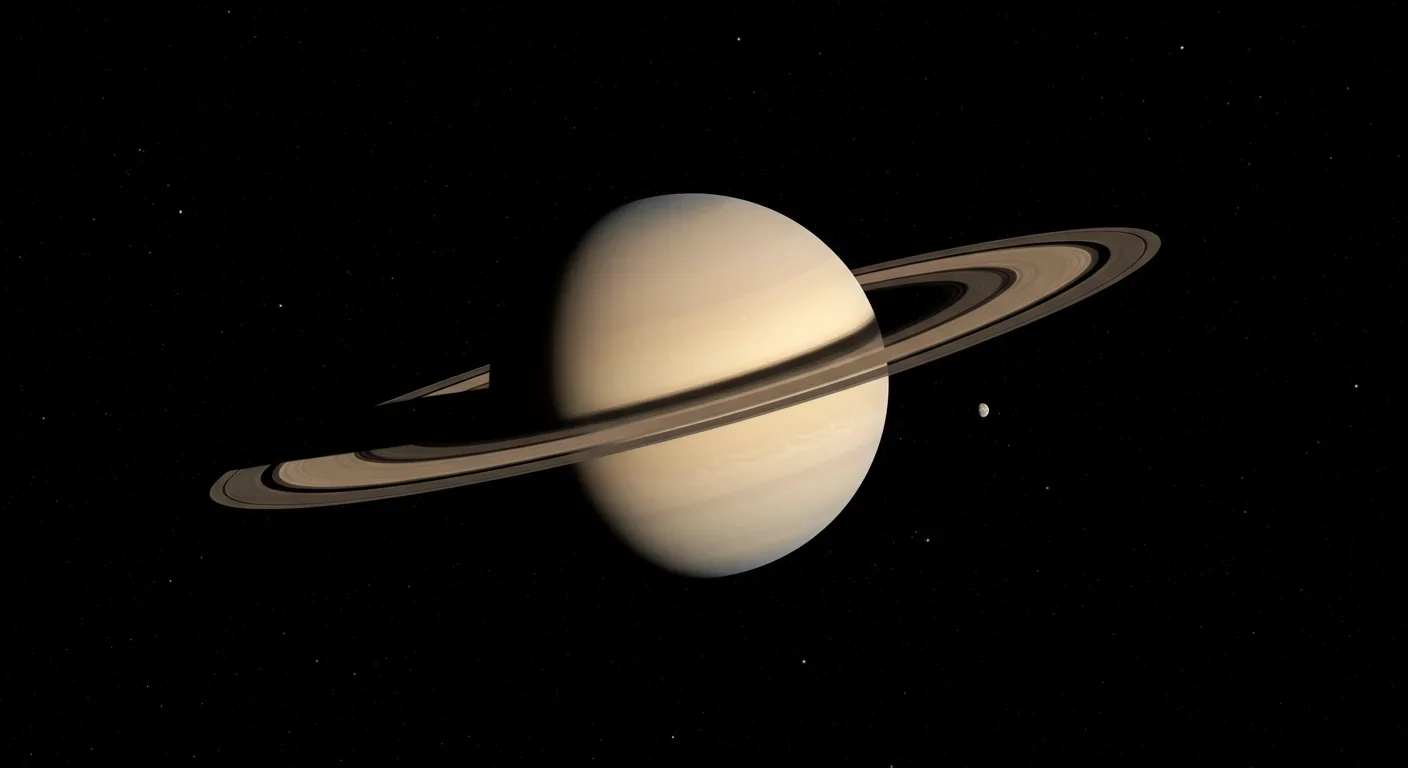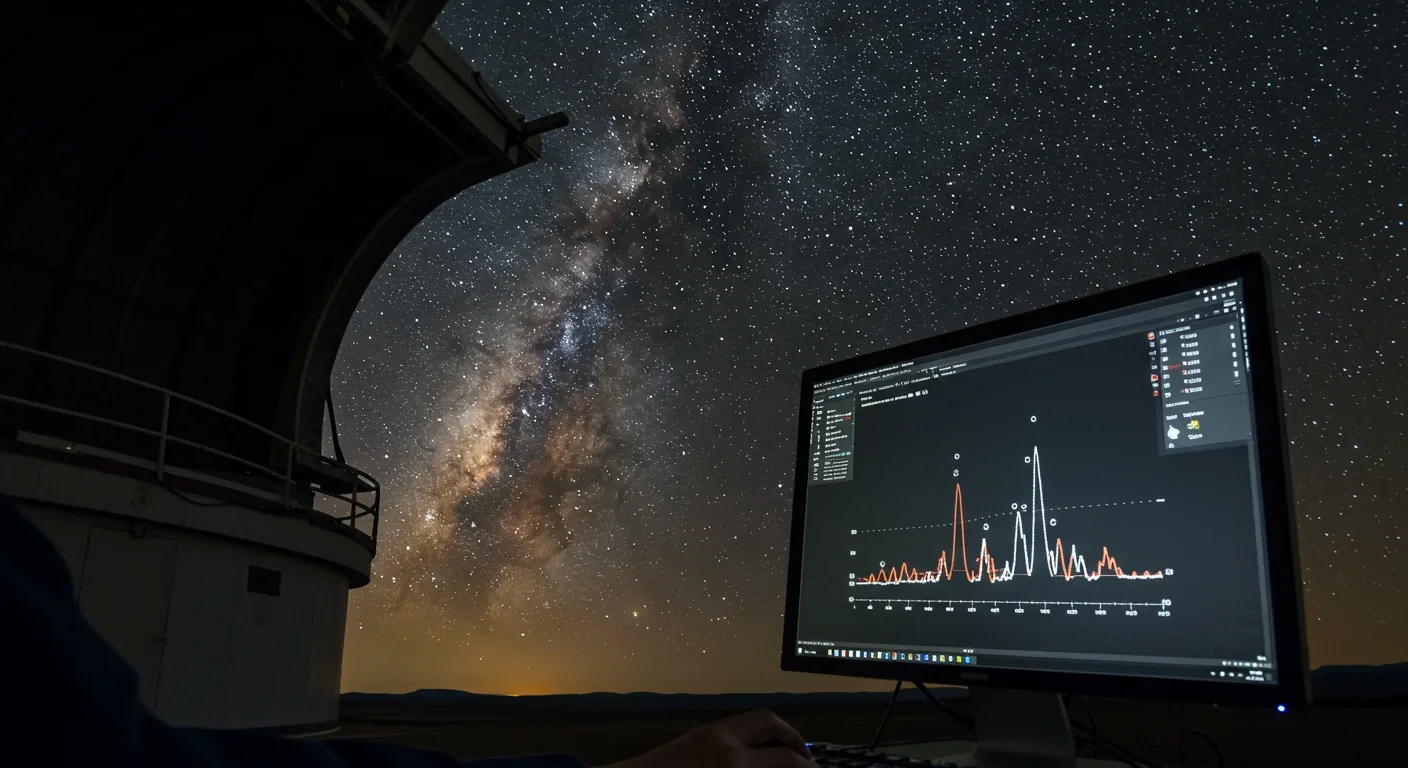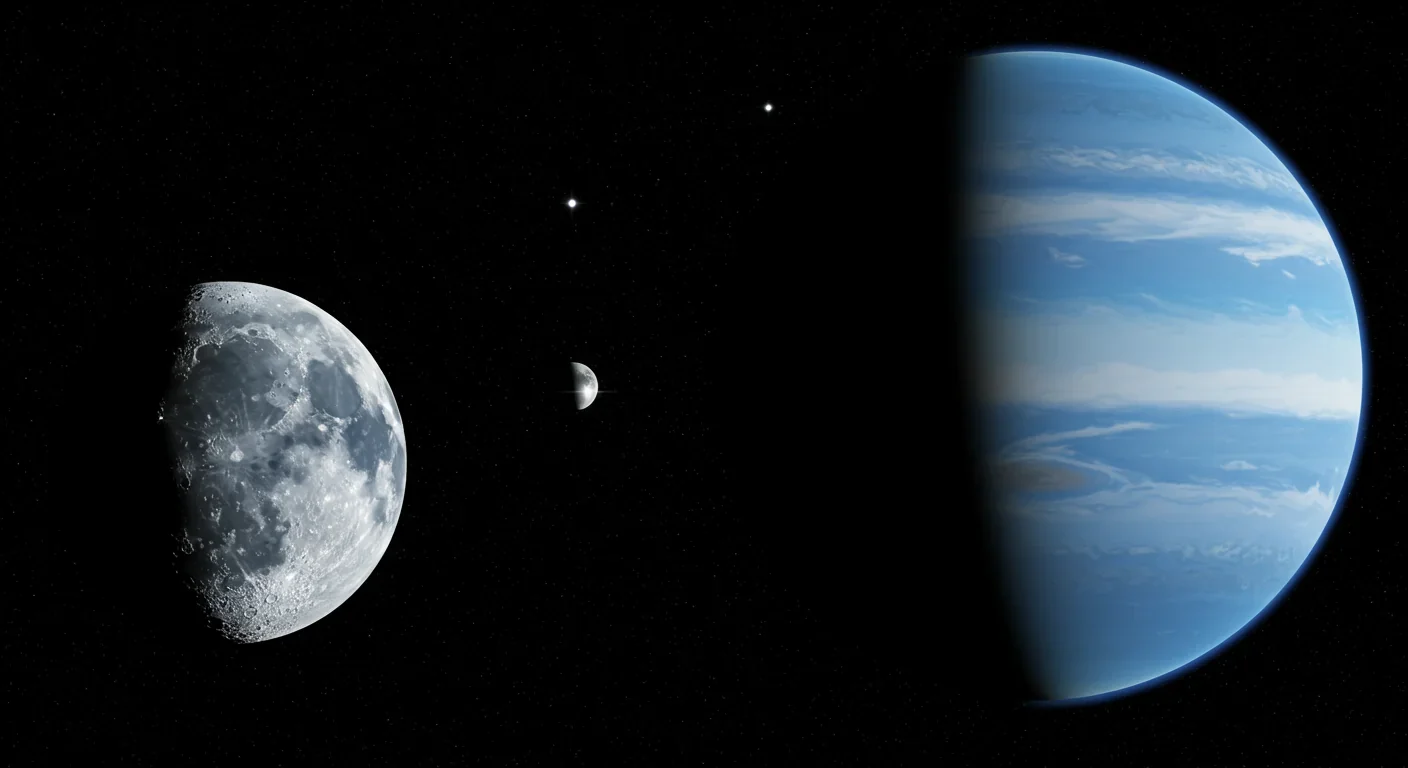Saturn's Rings: What Cassini Revealed About Their Fate

TL;DR: More than half of all stars exist in binary systems, and scientists have confirmed dozens of planets orbiting these dual-sun configurations. Contrary to earlier assumptions, binary star systems may actually enhance habitability through tidal effects that calm stellar activity, while offering extended habitable zones and diverse planetary architectures including circumbinary planets and potentially habitable exomoons. From Kepler-16b's iconic double sunsets to the temperate worlds of Kepler-47, these discoveries double the real estate for life in the universe and challenge our single-star perspective on where habitable worlds can exist.

In 2011, astronomers using NASA's Kepler Space Telescope discovered something that made science fiction real: a Saturn-sized planet orbiting not one, but two suns. Kepler-16b, located 245 light-years from Earth, became the first confirmed circumbinary planet—a world where inhabitants would witness double sunsets reminiscent of Luke Skywalker's iconic Tatooine. Yet this discovery was just the beginning. Today, researchers are uncovering that binary star systems—pairs of stars locked in gravitational embrace—may actually be better homes for life than our solitary Sun.
More than half of all stars in the Milky Way have stellar companions. That's billions upon billions of binary systems, each potentially hosting planets in configurations we're only beginning to understand. The question isn't whether planets can survive around two suns—we've confirmed dozens already. The real mystery is whether the complex dance of dual stellar radiation, gravitational tides, and orbital dynamics creates environments hostile to life, or whether it might offer advantages our single-star perspective never imagined.
Binary star systems consist of two stars orbiting their common center of mass, bound together by gravity for billions of years. These stellar pairs come in stunning variety: massive blue giants paired with Sun-like yellow dwarfs, twin Sun-analogues, or combinations where a brilliant primary star dwarfs a dim red companion that contributes less than one percent of the system's total light.
Research indicates that approximately one-third of all star systems in the Milky Way are binary or multiple-star configurations, with the remaining two-thirds being single stars like our Sun. Some estimates suggest the fraction may be even higher—up to 50% for Sun-like stars. This prevalence is crucial: if binary systems were universally hostile to planets or life, we'd be cutting our search for habitable worlds roughly in half.
Binary stars are classified by how we observe them. Visual binaries are wide enough that telescopes can resolve both stars separately. Spectroscopic binaries are detected through Doppler shifts in their combined light as they orbit. Eclipsing binaries—the gold standard for planet detection—regularly pass in front of each other from our viewpoint, causing periodic brightness dips that reveal precise stellar masses, radii, and temperatures. These eclipsing systems have become laboratories for understanding how planets form and persist in gravitationally complex environments.
The discovery of planets in these systems challenges foundational assumptions. For decades, planetary scientists believed the gravitational chaos of two massive bodies would eject forming planets or grind them to dust. The main problem with forming and maintaining planets around two stars is the three-body gravitational interaction: smaller bodies typically get ejected from orbit or fall onto one of the stars. Yet nature, it turns out, found stable solutions we failed to predict.
Kepler-16b shattered expectations in 2011, but it was the Kepler-47 system that revealed the true potential of circumbinary worlds. Discovered in 2012, Kepler-47 became the first confirmed multi-planet circumbinary system. Two stars—a Sun-like primary at 84% solar brightness and a diminutive red dwarf one-third the Sun's size and less than one percent as bright—orbit each other every 7.5 days. Around this binary pair, two planets complete the family.
Kepler-47b, the inner planet, is three times Earth's radius and orbits the stellar duo in less than 50 days, making it the smallest known transiting circumbinary planet. The outer world, Kepler-47c, is the real prize: a Neptune-sized gas giant that completes one orbit every 303 days at a distance of 0.99 AU, placing it squarely within the system's habitable zone. While Kepler-47c itself is too large to be rocky—likely a gaseous giant with thick water-vapor clouds—the possibility of large moons with atmospheres and magnetic fields capable of sustaining liquid water has captivated astrobiologists.
By 2024, the inventory had grown substantially. The list of exoplanets discovered that year includes dozens in binary systems, with configurations ranging from hot Jupiters in ultra-short orbits to temperate worlds at Earth-like distances. TOI-6383Ab, a Jupiter-mass planet orbiting an M-dwarf star in a binary system located 560 light-years away, exemplifies a particularly intriguing case. This massive planet orbiting a low-mass red dwarf in just 1.79 days challenges the core-accretion model of planet formation and supports rapid disk-fragmentation scenarios—suggesting that binary companions may actually facilitate giant planet formation under certain conditions.

The first circumbinary planet discovered by NASA's Transiting Exoplanet Survey Satellite (TESS) was TOI-1338 b in 2019, a Neptune-to-Saturn-sized world orbiting a visually eclipsing binary pair. As of July 2025, TESS had identified 7,655 candidate exoplanets, of which 638 have been confirmed—and a growing fraction orbit binary stars. Each new detection refines our understanding of where planets can form, how they migrate, and which orbital configurations remain stable over billions of years.
Planets in binary systems occupy two fundamentally different orbital configurations, classified by their relationship to the stellar pair. S-type (circumstellar) orbits see a planet hugging close to one star, effectively ignoring the distant companion. P-type (circumbinary) orbits encircle both stars, with the planet treating the binary as a single gravitational source at the center.
For circumbinary planets, stability hinges on a critical radius. The minimum stable separation between the stars and a circumbinary planet is approximately 2–4 times the binary star separation, corresponding to orbital periods roughly 3–8 times the binary period. The innermost planets in all the Kepler circumbinary systems orbit close to this stability threshold—a natural "exclusion zone" carved by gravitational resonances.
This boundary arises from Lindblad resonances within the protoplanetary disk. As gas and dust swirl around a young binary, spiral density waves at specific resonances sweep material outward, excavating an inner cavity. The cavity's size scales with binary separation and eccentricity, effectively setting a minimum orbital radius for any planet that forms or migrates inward. Planets that venture too close experience chaotic perturbations: their orbits precess, wobble, and ultimately destabilize, leading to ejection or collision with one of the stars.
Kepler-16b's orbit illustrates this principle. The two stars in Kepler-16 have masses of 0.69 and 0.20 solar masses, orbiting each other every 41 days. Kepler-16b orbits the pair every 229 days at a distance of approximately 0.7 AU—just outside the critical stability radius, which earlier models predicted would require seven times the binary separation. Instead, Kepler-16b orbits at roughly half that distance, demonstrating that nature navigates the stability boundary with remarkable precision.
Circumbinary planets generally settle into orbits 1.09–1.46 times the critical radius, a clustering that suggests planet migration stalls near this boundary. Type I migration—driven by gravitational torques from the disk—appears to halt when a planet reaches the edge of the tidally truncated cavity, unable to push farther inward. This natural stopping mechanism may explain why circumbinary planets are both rare and, when found, located in a narrow orbital range.
The habitable zone—the region around a star where liquid water can exist on a planet's surface—takes on a dynamic, complex character in binary systems. For single stars, the habitable zone is a simple annulus at a fixed distance. In a binary system, the zone becomes a ring that moves as the stars orbit, and its boundaries shift based on the combined luminosity and relative positions of both stellar components.
Kepler-47 provides a vivid example. The habitable zone of the system is ring-shaped and centered on the larger star. As the primary star orbits the center of mass every 7.5 days, the ring itself shifts position. A planet within this zone experiences time-varying illumination: periods of continuous daylight when both stars are visible, twilight phases when one star sets, and potentially brief intervals of relative darkness depending on the planet's orbital phase. This variability could drive complex atmospheric circulation patterns and seasonal cycles unlike anything on Earth.
Recent research shows that the habitable zone in a binary system can be shifted outward by up to 2.4 AU compared to a single-star analog, depending on binary separation and mass ratio. The combined luminosity of two stars extends the outer edge of the zone, while tidal heating and radiation variability may destabilize conditions at the inner edge. For Kepler-47c, which receives approximately 87.3% of Earth's solar flux from its dual suns, the insolation is actually lower than Earth's—placing it near the cool edge of the habitable zone. A thicker atmosphere with greenhouse gases could warm the planet (or its moons) sufficiently to maintain liquid water.
Yet variable stellar radiation poses challenges. A circumbinary planet's distance from the binary center of mass changes as the stars orbit, producing flux variations on the timescale of the binary period. For a planet in a 303-day orbit around a 7.5-day binary, the stellar radiation pattern repeats dozens of times per planetary year, potentially driving rapid climatic oscillations. Whether life could adapt to such variability—or even thrive in environments where day-night cycles and seasonal insolation patterns differ radically from Earth—remains an open question.
Surprisingly, some binary configurations may enhance habitability. Paul Mason and colleagues at New Mexico State University discovered that tidal interactions in close binaries can slow stellar rotation rates—a process they call "premature aging." Red dwarf stars, notorious for powerful magnetic activity and flare events that strip planetary atmospheres, normally take billions of years to spin down. In a binary system with orbital periods between 10 and 100 days, tidal torques synchronize the stars' spins within a few hundred million years, dramatically reducing magnetic activity and creating an earlier window for habitability. Mason notes, "The star's not actually getting older, it just seems older, as its spin and radiation are reduced earlier in its lifetime."
There's a catch: if the stars are too close—with orbital periods less than 10 days—they'll keep spinning quickly and remain "forever young," maintaining destructive stellar winds indefinitely. If they're too far apart, tidal effects become negligible. Only a narrow window of binary separations optimally balances reduced stellar activity with orbital stability, creating habitable environments that single-star systems cannot match.
Detecting planets around binary stars requires overcoming observational hurdles that single-star planet searches don't face. The transit method—measuring tiny brightness dips when a planet crosses in front of its star—becomes vastly more complicated when two stars are eclipsing each other. Circumbinary planets are generally more likely to transit than planets around single stars because the geometry is favorable: if the binary eclipses, any circumbinary planet's orbit is likely edge-on as well. Yet the combined light from both stars, the periodic eclipses, and the planet's own transits create a complex light curve requiring sophisticated modeling to disentangle.
Kepler-16b's discovery hinged on detecting subtle, non-periodic brightness dips superimposed on the regular 41-day eclipses of the binary stars. The planet's 229-day orbit meant transits occurred at irregular intervals, each slightly offset from the last due to orbital precession. Identifying this signal required both automated algorithms and careful human scrutiny—a combination that has become the gold standard for circumbinary planet detection.
The radial-velocity method—detecting the wobble a planet induces in its star's motion via Doppler shifts—faces even greater challenges in binary systems. Spectral lines from both stars overlap, and the binary's mutual orbit produces large Doppler signals that can mask the smaller planetary signature. Advanced techniques such as Gaussian Process regression have become essential for separating planetary signals from stellar activity and the composite spectrum. In 2021, Kepler-16b became the first circumbinary planet detected by the radial-velocity method, a breakthrough that validated the technique for binary systems.
NASA's Transiting Exoplanet Survey Satellite (TESS) has proven instrumental in expanding the circumbinary planet census. TESS uses four wide-field cameras to monitor 85% of the sky, targeting the brightest nearby stars—ideal candidates for follow-up atmospheric characterization with the James Webb Space Telescope (JWST). Because TESS focuses on bright stars, its planets are accessible to rapid spectroscopic and imaging follow-up, enabling comprehensive studies of binary-hosted worlds.
The existence of circumbinary planets poses a fundamental puzzle: how do planets form in an environment where gravitational perturbations should prevent small bodies from coalescing? The answer lies in the behavior of protoplanetary disks around young binaries.
When gas and dust fall onto a binary star system, angular momentum shapes the material into circumstellar disks around each star and a circumbinary disk encircling both. The circumbinary disk exhibits a central cavity excavated by spiral density waves at Lindblad resonances—locations where the orbital period of disk material resonates with the binary period. The cavity radius is typically 2–3 times the binary semi-major axis, creating a dust- and gas-depleted region inside which planet formation is suppressed.
Beyond the cavity edge, however, conditions can be favorable. Dust traps form at the pressure maxima along the cavity boundary, concentrating solid particles and accelerating planetesimal growth. Numerical simulations show that small, rocky planets are almost as likely to form in close binaries (separated by no more than 0.1 AU) as around single stars, provided the binary separation remains below this threshold. For wider binaries, the truncation radius moves outward, expanding the planet-forming zone but also reducing the available disk mass.

Two competing scenarios explain giant planet formation around low-mass stars in binaries. The core-accretion model requires a solid core to form first, then accrete gas—a process that struggles in low-mass disks around M-dwarfs. The rapid disk-fragmentation model bypasses this bottleneck: if the disk cools quickly, gravitational instabilities fragment it directly into clumps that collapse into gas giants. The discovery of TOI-6383Ab—a Jupiter-mass planet around an M3-dwarf in a binary system—strongly supports the fragmentation scenario, as the disk mass around such a small star would be insufficient for core accretion.
If circumbinary gas giants exist in habitable zones, could their moons be the real abodes of life? Recent simulations exploring exomoons around migrating circumbinary planets reveal a fascinating and complex picture.
Moons form close to their host planet, typically within the planet's Hill sphere—the region where the planet's gravity dominates over the binary stars. As a gas giant migrates inward through the circumbinary disk due to Type I migration, moons experience differential tidal forces. Simulations show that a moon can survive migration if it forms within approximately 5–10% of the planet's Hill radius; moons farther out fall off their host planet early in the migration and become independent circumbinary planets—creating multi-planet circumbinary systems. A subset of moons are ejected from the system entirely.
Roughly 30–40% of surviving moons end up in the habitable zone after full migration, even when hosted by gas giants. These moons, if sufficiently massive, could possess thick atmospheres rich in nitrogen and methane (resembling Saturn's moon Titan), and magnetic fields strong enough to deflect the combined stellar winds of the binary. Large moons with enough atmosphere and a magnetic field could sustain liquid water on gas giants like Kepler-47c, transforming these gaseous worlds into viable platforms for habitable satellites.
No binary system has captured scientific and public imagination quite like Alpha Centauri. The A and B components orbit each other every 79.8 years, with a periastron (closest approach) of 11.2 AU and apastron (farthest separation) of 35.6 AU. This eccentric orbit creates a dynamically evolving habitable zone for any circumstellar planet: a planet orbiting Alpha Centauri A must remain within roughly 3 AU to stay stable over billions of years, and the habitable zone—conservatively estimated at 1.37 to 1.76 AU for Alpha Centauri A—lies comfortably within this stability window.
Proxima Centauri, the third member of the system, orbits the A-B pair at a distance of approximately 13,000 AU. Proxima hosts at least one confirmed planet, Proxima Centauri b, which orbits every 11.18 days at a distance of 0.049 AU, placing it within Proxima's habitable zone. Yet Proxima is a flare star with intense magnetic activity: the effective temperature is only 3,050 K, radiating just 0.005% of the Sun's visible light, but flares can produce magnetic fields up to 600 Gauss and extreme ultraviolet (XUV) radiation capable of stripping planetary atmospheres.
The JWST candidate planet around Alpha Centauri A exemplifies both the promise and challenges of detecting planets in nearby binaries. Coronagraphic imaging removed Alpha Centauri A's glare and the scattered light from Alpha Centauri B, revealing a source approximately 10,000 times fainter than the star at a separation of roughly 2 AU. Computer models simulated millions of potential orbits, requiring gravitational stability in the presence of Alpha Centauri B. The planet's disappearance in subsequent observations forced researchers to refine orbital models, demonstrating the difficulty of confirming low-contrast planets around very bright stars in close binary systems.
The field stands at a pivotal moment. With nearly 600 edge-on binary star systems cataloged from ESA's Gaia DR3 data, astronomers have a treasure trove of prime targets for planet searches. Edge-on binaries offer unique advantages: the geometry boosts radial-velocity detection signals (the Doppler wobble is maximized when orbital motion is along our line of sight), and these systems can serve as "control samples" for comparative planet formation studies—analogous to twin studies in biology, where identical initial conditions allow researchers to isolate the effects of specific variables.
Advances in instrumentation promise to accelerate discovery. JWST's coronagraphic modes enable direct imaging of planets around bright nearby binaries like Alpha Centauri. Ground-based extremely large telescopes under construction—such as the European Extremely Large Telescope (ELT) and the Thirty Meter Telescope (TMT)—will push direct imaging to smaller, cooler planets. High-resolution spectrographs like HARPS, HIRES, and EXPRES achieve radial-velocity precision down to 3 meters per second, enabling detection of Neptune-mass planets in temperate orbits.
The discovery and characterization of circumbinary planets fundamentally expands the real estate available for life in the universe. If binary star systems—comprising one-third to one-half of all stellar systems—can host stable, habitable planets, the number of potential biospheres in the Milky Way effectively doubles.
Yet habitability in binary systems comes with caveats. Variable stellar radiation from dual suns may drive rapid climate oscillations, challenging the development of complex life. Stellar activity, particularly in close binaries with young, magnetically active stars, can erode atmospheres unless planets possess strong magnetic fields or thick atmospheres. Tidal locking in close orbits around red dwarfs may create day-side deserts and night-side ice caps, confining habitable conditions to narrow terminator zones.
Conversely, binary systems offer unique advantages. Tidal synchronization in close binaries can prematurely reduce stellar activity, creating habitability windows millions or even billions of years earlier than around single stars. The extended habitable zones created by combined stellar luminosity may allow temperate conditions at greater distances, reducing tidal locking risks. Dust traps and pressure maxima in circumbinary disks may accelerate rocky planet formation, potentially making terrestrial worlds more common around binaries than previously assumed.
Exomoons around gas giants in circumbinary habitable zones represent a largely unexplored pathway to life. With 30–40% of surviving moons landing in the habitable zone after migration, and the potential for thick atmospheres, magnetic shielding, and subsurface oceans heated by tidal flexing, these moons may rival or exceed the habitability of their host planets.
The search for biosignatures—oxygen, methane, water vapor, and other markers of life—will require accounting for the unique atmospheric chemistry driven by variable irradiation. Continuous daylight phases on circumbinary planets could alter photosynthetic cycles, while prolonged twilight might favor different metabolic pathways. Detecting these signatures will demand high-resolution transmission spectroscopy with JWST and future missions, coupled with models that incorporate binary-specific environmental factors.
The discovery that planets not only survive but potentially thrive around binary stars has rewritten our understanding of planetary habitability. From Kepler-16b's iconic double sunsets to the temperate circumbinary worlds of Kepler-47, from the Jupiter-mass giants orbiting red dwarf binaries to the exomoons that may harbor hidden oceans, the diversity of worlds in binary systems challenges and enriches the narrative of where life might arise.
We stand on the threshold of a new era. The next generation of telescopes will image planets around Alpha Centauri and other nearby binaries, revealing atmospheres, surface compositions, and perhaps even signs of life. Citizen scientists and AI algorithms will sift through millions of light curves, uncovering rare circumbinary transits and expanding the census of dual-sun worlds. Theoretical models will map the stability boundaries, habitable zone evolution, and atmospheric dynamics of these exotic systems with ever-greater precision.
Binary star systems are no longer exotic footnotes in the exoplanet catalog. They are fundamental laboratories for understanding planet formation, migration, and habitability in gravitationally complex environments. They may host a significant fraction—perhaps even a majority—of the galaxy's habitable worlds. And they remind us that the universe's capacity for creating life-bearing worlds is richer, stranger, and more wonderful than we ever imagined when we looked up and saw only one sun in our sky.
The double sunsets of science fiction have become scientific fact. The question now is not whether planets can exist around two suns, but how many of them are home to life looking up at their own binary skies, wondering if they're alone.

Saturn's iconic rings are temporary, likely formed within the past 100 million years and will vanish in 100-300 million years. NASA's Cassini mission revealed their hidden complexity, ongoing dynamics, and the mysteries that still puzzle scientists.

Scientists are revolutionizing gut health by identifying 'keystone' bacteria—crucial microbes that hold entire microbial ecosystems together. By engineering and reintroducing these missing bacterial linchpins, researchers can transform dysfunctional microbiomes into healthy ones, opening new treatments for diseases from IBS to depression.

Marine permaculture—cultivating kelp forests using wave-powered pumps and floating platforms—could sequester carbon 20 times faster than terrestrial forests while creating millions of jobs, feeding coastal communities, and restoring ocean ecosystems. Despite kelp's $500 billion in annual ecosystem services, fewer than 2% of global kelp forests have high-level protection, and over half have vanished in 50 years. Real-world projects in Japan, Chile, the U.S., and Europe demonstrate economic via...

Our attraction to impractical partners stems from evolutionary signals, attachment patterns formed in childhood, and modern status pressures. Understanding these forces helps us make conscious choices aligned with long-term happiness rather than hardwired instincts.

Crows and other corvids bring gifts to humans who feed them, revealing sophisticated social intelligence comparable to primates. This reciprocal exchange behavior demonstrates theory of mind, facial recognition, and long-term memory.

Cryptocurrency has become a revolutionary tool empowering dissidents in authoritarian states to bypass financial surveillance and asset freezes, while simultaneously enabling sanctioned regimes to evade international pressure through parallel financial systems.

Blockchain-based social networks like Bluesky, Mastodon, and Lens Protocol are growing rapidly, offering user data ownership and censorship resistance. While they won't immediately replace Facebook or Twitter, their 51% annual growth rate and new economic models could force Big Tech to fundamentally change how social media works.